How technology helped me increase yields on my mushroom farm
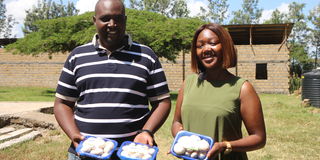
Meidimi Sokoto and his wife MaryAnn Meidimi, hold out some of the mushroom from their mushroom farm.
Meidimi Sokoto, a button mushroom farmer from Kabarak, Nakuru, started his journey in 2015 when he built his first mud house for mushroom farming.
In 2020, during the COVID-19 pandemic, while farming in Karen, Nairobi, he realised that he continued to face the same challenges, including disease, temperature control and the need for better yields.
"Mushrooms are a very temperature-sensitive crop, and while mud houses do a good job of controlling temperature, they don't prevent disease. Once the temperature rises above a certain point, they may not be good for selling and that's not good for business," explains Meidimi.
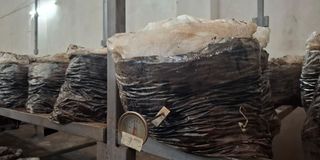
A humidifier in one of the grow houses to measure humidity.
You see, before mushroom farming became a thing, the vegetable was mostly collected from the forest or wherever it wildly grew.
Over time, however, farmers became interested in cultivating the plant, so they started building thatched mud houses to use for production, but this came at a cost.
To overcome these challenges, Mr Sokoto researched ways to improve the efficiency of his farm and his research led him to the conclusion that mechanisation of his farm would be crucial.
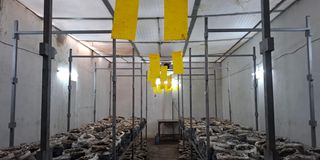
Inside one of the mechanised grow houses at Meidimi's farm.
With this in mind, he decided to return to Nakuru and build a permanent structure for his farm.
In his quest for knowledge, Mr Sokoto sought out experts in the field.
"I contacted some big farms overseas that had improved their mushroom farms, but most of them only worked with large-scale farmers and couldn't help me, which was disappointing. So I continued to search and study online," he recalls.
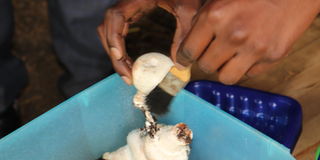
Button mushroom being cleaned off soil before packing, this ensures customers get non-contaminated food.
He finally found someone in South Africa willing to teach him the intricacies of modern mushroom farming, and travelled there for hands-on training, learning the best practices for running a successful mechanised mushroom farm.
Yellow fly traps hang from the ceilings of his 13m by 6m stone-walled facilities, lit by coloured fluorescent bulbs placed in strategic locations.
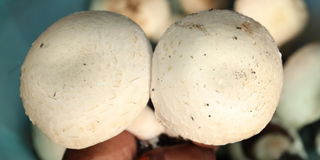
Button mushrooms.
Thermometers and humidifiers are also strategically placed, with the whole operation powered by electricity.
Mr Sokoto explains that this automation is key to improving productivity and optimising growing conditions for the mushrooms.
Like many mushroom farmers, he has to buy imported seeds (spores), while everything else, including manure and wheat straw, is available locally.
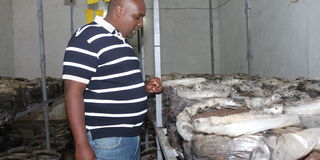
Meidimi Sokoto, in his mechanized mushroom farm in Nakuru.
"The spores I use come from South Africa. However, many smaller farmers like me buy the spores from the larger farms that import them," he explains.
Despite the initial challenges, Mr Sokoto's farm has grown and he now produces close to 1000 punnets of mushrooms per season.
Although he's able to produce this much, local mushroom farmers and himself are still unable to meet the market demand.
Today, Meidimi is an advocate for mechanised mushroom farming and believes that with the right training and investment, small farmers can improve their business and ensure a steady supply for the local market.
"Investing in the right information is critical to success, as the expertise required to grow mushrooms is more specialised and costly than many other crops," he says.


